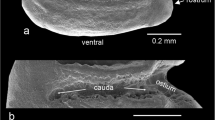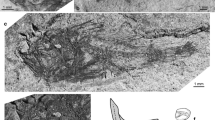Abstract
Aphanius Nardo, 1827 (Actinopterygii, Cyprinodontidae) is a widely distributed genus in the Mediterranean and Persian Gulf area and includes several endangered species. The otolith morphology in Aphanius is known to represent a valuable tool for the taxonomy, and is also indicative for the genetic diversity of a particular population. The present study focuses on the otoliths of the endangered A. ginaonis (Holly, 1929), which is endemic to the Geno hot spring in southern Iran. The taxonomic status of A. ginaonis has repeatedly been questioned, and some scholars have argued that it merely represents a morphological variation of the widespread A. dispar. We present a comparison of the otolith morphology of A. ginaonis (52 specimens) with that of A. dispar (Rüppell, 1828) from the Mehran River Basin (southern Iran) (17 specimens) and an A. dispar population from the Persian Gulf coast of the United Arab Emirates (32 specimens). Our data obtained from SEM pictures, otolith morphometry and statistical analyses suggest that A. ginaonis represents a valid species. In A. ginaonis individuals with a standard length exceeding 23 mm, the otolith variables length–height and rostrum length represent useful complementary diagnostic characters discriminating this species from other Aphanius species. Besides ontogenetic variation, we found extremely high otolith form variability in A. ginaonis, including some otoliths with a morphology distinctly deviating from the basic morphology type. We hypothesize that these variations may be a result of the artificial introduction of A. dispar into the Geno hot spring during the last years and subsequent hybridisation.







Similar content being viewed by others
References
Blanco JL, Hrbek T, Doadrio I (2006) A new species of the genus Aphanius (Nardo, 1832) (Actinopterygii, Cyprinodontidae) from Algeria. Zootaxa 1158:39–53
Campana SE, Casselman JM (1993) Stock discrimination using otolith shape analysis. Can J Fish Aquat Sci 50:1062–1083
Cardinale M, Doering-Arjes P, Kastowsky M, Mosegaard H (2004) Effects of sex, stock, and environment on the shape of known-age Atlantic cod (Gadus morhua) otoliths. Can J Fish Aquat Sci 61:158–167
Clavero M, Blanco-Garrido F, Prenda J (2007) Population and microhabitat effects of interspecific interactions on the endangered Andalusian toothcarp (Aphanius baeticus). Environ Biol Fish 78:173–182
Coad BW (1980) A re-description of Aphanius ginaonis (Holly, 1929) from southern Iran (Osteichthyes; Cyprinodontiformes). J Nat Hist 14:33–40
Coad BW (1998) Threatened fishes of the world: Lebias ginaonis (Holly, 1929) (Cyprinodontidae). Environ Biol Fish 51:284
Coad BW (2000) Distribution of Aphanius species in Iran. J Amer Killifish Assoc 33:183–191
Coad BW, Abdoli A (2000) Systematics of an isolated population of tooth-carp from northern Iran (Actinopterygii: Cyprinodontidae). Zool Middle East 21:87–102
DeVries DA, Grimes CB, Prager MH (2002) Using otolith shape analysis to distinguish eastern Gulf of Mexico and Atlantic Ocean stocks of king mackerel. Fish Res 57:51–62
Doadrio I, Carmona JA, Fernández-Delgado C (2002) Morphometric study of the Iberian Aphanius (Actinopterygii, Cyprinodontiformes), with description of a new species. Folia Zool 51:67–79
Esmaeili HR, Ebrahimi M, Saifali M (2008) Karyological analysis of five tooth-carps (Actinopterygii: Cyprinodontidae) from Iran. Micron 39:95–100
Fernández-Pedrosa V, González A, Planelles M, Moya A, Latorre A (1995) Mitochondrial DNA variability in three Mediterranean populations of Aphanius iberus. Biol Conserv 72:251–256
Feulner GR (1998) Wadi fish of the UAE. Tribulus 8:16–22
Feulner GR (2005) Freshwater fishes. In: Hellyer P, Aspinall S (eds) The emirates—a natural history. Trident, London, pp 257–259
Frenkel V, Goren M (1997) Some environmental factors affecting the reproduction of Aphanius dispar (Rüppell, 1828). Hydrobiol 347:197–207
Hrbek T, Meyer A (2003) Closing of the Tethys Sea and the phylogeny of Eurasian killifishes (Cyprinodontiformes: Cyprinodontidae). J Evol Biol 16:17–36
Hrbek T, Keivany Y, Coad BW (2006) New species of Aphanius (Teleostei, Cyprinodontidae) from Isfahan Province of Iran and a reanalysis of other Iranian species. Copeia 2006:244–255
Katayama S, Isshiki T (2007) Variation in otolith macrostructure of Japanese flounder (Paralichthys olivaceus): a method to discriminate between wild and released fish. J Sea Res 57:180–186
Krupp F (1983) Freshwater fishes of Saudi Arabia and adjacent regions of the Arabian Peninsula. Fauna Saudi Arabia 5:568–636
Leonardos I, Sinis A (1999) Population age and sex structure of Aphanius fasciatus Nardo, 1827 (Pisces: Cyprinodontidae) in the Mesolongi and Etolikon lagoons (W. Greece). Fish Res 40:227–235
Lombarte A, Castellón A (1991) Interspecific and intraspecific otolith variability in the genus Merluccius as determined by image analysis. Can J Zool 69:2442–2449
Lombarte A, Lleonart J (1993) Otolith size changes related with body growth, habitat depth and body temperature. Environ Biol Fish 37:297–306
Lombarte A, Torres GJ, Morales-Nin B (2003) Specific Merluccius otolith growth patterns related to phylogenetics and environmental. J Mar Biol Assoc UK 83:277–281
Maltagliati F, Domenici P, Fosch CF, Cossu P, Casu M, Castelli A (2003) Small-scale morphological and genetic differentiation in the Mediterranean killifish Aphanius fasciatus (Cyprinodontidae) from a coastal brackish-water pond and an adjacent pool in northern Sardinia. Oceanol Acta 26:111–119
Maltagliati F, Lai T, Casu M, Valdesalici S, Castelli A (2006) Identification of endangered Mediterranean cyprinodontiform fish by means of DNA inter-simple sequence repeats (ISSRs). Biochem Syst Ecol 34:626–634
Mérigot B, Letourneur Y, Lecomte-Finiger R (2007) Characterization of local populations of the common sole Solea solea (Pisces, Soleidae) in the NW Mediterranean through otolith morphometrics and shape analysis. Mar Biol 151:997–1008
Monteiro LR, Di Beneditto APM, Guillermo LH, Rivera LA (2005) Allometric changes and shape differentiation of sagitta otoliths in sciaenid fishes. Fish Res 74:288–299
Morales-Nin B, Torres GJ, Lombarte A, Recasens L (1998) Otolith growth and age estimation in the European hake. J Fish Biol 53:1155–1168
Moreno-Amich R, Pou Q, Quintana X, García-Berthou E (1999) Efecto de la regulación hídrica en la conservación del fartet (Lebias ibera) en Aiguamolls de L’Empordà: Importancia de los refugios de población. In: Planelles-Gomis M (ed) Peces Ciprinodóntidos Ibéricos Fartet y Samaruc. Generalitat Valenciana, Valencia, pp 115–131
Nolf D (1985) Otolithi piscium. Handbook of paleoichthyology, vol 10. Gustav Fischer, Stuttgart
Nolf D (1995) Studies on fossil otoliths—the state of the art. In: Secor DH, Dean JM, Campana SE (eds) Recent developments in fish otolith research. University of South Carolina Press, Columbia, pp 513–544
Oliva-Paterna FJ, Ignacio Doadrio I, Fernández-Delgado C (2006) Threatened fishes of the world: Aphanius baeticus (Doadrio, Carmona and Fernández-Delgado, 2002) (Cyprinodontidae). Environ Biol Fish 75:415–417
Popper AN, Ramcharitar JU, Campana SE (2005) Why otoliths? Insights from inner ear physiology and fisheries biology. Mar Freshw Res 56:497–504
Reichenbacher B, Sienknecht U (2001) Allopatric divergence and genetic diversity of recent Aphanius iberus and fossil Prolebias meyeri (Teleostei, Cyprinodontidae) from southwest and western Europe, as indicated by otoliths. Geobios 34:69–83
Reichenbacher B, Sienknecht U, Küchenhoff H, Fenske N (2007) Combined otolith morphology and morphometry for assessing taxonomy and diversity in fossil and extant killifish (Aphanius, †Prolebias). J Morphol 268:898–915
Reichenbacher B, Feulner GR, Schulz-Mirbach T (2009) Geographic variation in otolith morphology among freshwater populations of Aphanius dispar (Teleostei, Cyprinodontiformes) from the Southeastern Arabian Peninsula. J Morphol 270:469–484. doi:10.1002/jmor.10702
Schulz-Mirbach T, Reichenbacher B, Yildirim Z, Atalay A (2006) Otolith characteristics of species, subspecies and populations of Aphanius Nardo, 1827 (Teleostei, Cyprinodontiformes) from Anatolia (Turkey). J Nat Hist 40:1687–1705
Schulz-Mirbach T, Scherb H, Reichenbacher B (2008) Are hybridization and polyploidization phenomena detectable in the fossil record?—A case study on otoliths of a natural hybrid, Poecilia formosa (Teleostei: Poeciliidae). N Jb Geol Paläont Abh 249:223–238
Sienknecht U (1999a) Diferencias genéticas a nivel de populación de Lebias ibera (Cuv. et Val. 1846) (Teleostei: Cyprinodontidae). In: Planelles-Gomis M (ed) Peces Ciprinodóntidos Ibéricos Fartet y Samaruc Monografía. Generalitat Valenciana, València, pp 213–223
Sienknecht U (1999b) Kreuzungsgenetische Analyse des Überganges von Paarflossen bis zu fehlendem Extremitätengürtel. Entwickelt am Beispiel der normogenetischen Ventralflossenbildung von Aphanius iberus (Cuv. and Val. 1846) im Vergleich zur Anormogenese seiner Hybriden mit A. apodus (Gervais 1853) (Teleostei: Cyprindontidae). Der Andere Verlag, Osnabrück
Smale MJ, Watson G, Hecht T (1995) Otolith atlas of southern African marine fishes. Ichthyological Monographs 1:1–253
SPSS Inc (2006) SPSS. Ver. 16.0. Base. Chicago, IL: SPSS, Inc.
Stransky C (2005) Geographic variation of golden redfish (Sebastes marinus) and deep-sea redfish (S. mentella) in the North Atlantic based on otolith shape analysis. ICES J Mar Sci 62:1691–1698
Stransky C, Baumann H, Fevolden SE, Harbitz A, Høie H, Nedreaas KH, Salberg AB, Skarstein T (2008) Separation of Norwegian coastal cod and Northeast Arctic cod by outer otolith shape analysis. Fish Res 90:26–35
Templeman W, Squire HJ (1956) Relationship of otolith lengths and weights in the haddock Melanogrammus aeglefinus (L.) to the rate of growth of the fish. J Fish Res Board Can 13:467–487
Tigano C, Canapa A, Ferrito V, Barucca M, Arcidiacono I, Deidun A, Schembri PJ, Omo E (2006) A study of osteological and molecular differences in populations of Aphanius fasciatus Nardo 1827, from the central Mediterranean (Teleostei, Cyprinodontidae). Mar Biol 149:1539–1550
Tuset VM, Lombarte A, González JA, Pertusa JF, Lorentes MJ (2003) Comparative morphology of the sagittal otolith in Serranus spp. J Fish Biol 63:1491–1504
Tuset VM, Lombarte A, Assis CA (2008) Otoliths atlas for the Western Mediterranean, North and Central Eastern Atlantic. Sci Mar 72S1:7–198
Villwock W (1977) Das Genus Aphanius Nardo, 1827. J dt Killif Gem 9:165–185
Villwock W (1985) Über Naturbastarde zwischen zwei validen Arten der Gattung Aphanius (Nardo, 1827) (Pisces: Cyprinodontidae) aus der Bardawil-Lagune, Nordsinai/Ägypten. Mitt Hamb Zool Mus Inst 82:311–317
Volpedo AV, Echeverría DD (2000) Catálogo y claves de otolitos para la identificación de peces del mar Argentino. Dunken, Buenos Aires
Volpedo A, Echeverría DD (2003) Ecomorphological patterns of the otolith in fish on the continental shelf off Argentina. Fish Res 60:551–560
Wildekamp RH (1993) A world of killies. Atlas of the Oviparous Cyprinodontiform fishes of the World, vol I. American Killifish Association, Mishawaka
Wildekamp RH, Küçük F, Ünlüsayin M, Neer WV (1999) Species and subspecies of the Genus Aphanius Nardo 1897 (Pisces: Cyprinodontidae) in Turkey. Tur J Zool. 23:23–44
Acknowledgments
Financial support was provided by the German Academic Exchange Service (DAAD, Middle East Biodiversity Network) and the Deutsche Forschungsgemeinschaft (Re 1113/14-1). Gary Feulner (Dubai, United Arab Emirates) provided the A. dispar specimens from Khor Hulaylah in the United Arab Emirates, Christine Frosch (Frankfurt, Germany) supplied the A. dispar specimens from Mehran River at Dezhgan, and Kai Borkenhagen (Frankfurt, Germany) provided the information of the habitat at Dezhgan. Nora Dotzler (Munich, Germany) helped with the otolith preparation, digital measurements of otoliths, and SEM images; R. Melzer (Munich, Germany) assisted with SEM. To all, we offer our sincere thanks. For constructive discussion we are grateful to M. Krings (Munich) and F. Krupp (Frankfurt), and for constructive comments on the manuscript we thank Christoph Stransky, an anonymous reviewer and the editor of the EBFi, David L.G. Noakes.
Author information
Authors and Affiliations
Corresponding author
Rights and permissions
About this article
Cite this article
Reichenbacher, B., Kamrani, E., Esmaeili, H.R. et al. The endangered cyprinodont Aphanius ginaonis (Holly, 1929) from southern Iran is a valid species: evidence from otolith morphology. Environ Biol Fish 86, 507–521 (2009). https://doi.org/10.1007/s10641-009-9549-5
Received:
Accepted:
Published:
Issue Date:
DOI: https://doi.org/10.1007/s10641-009-9549-5




